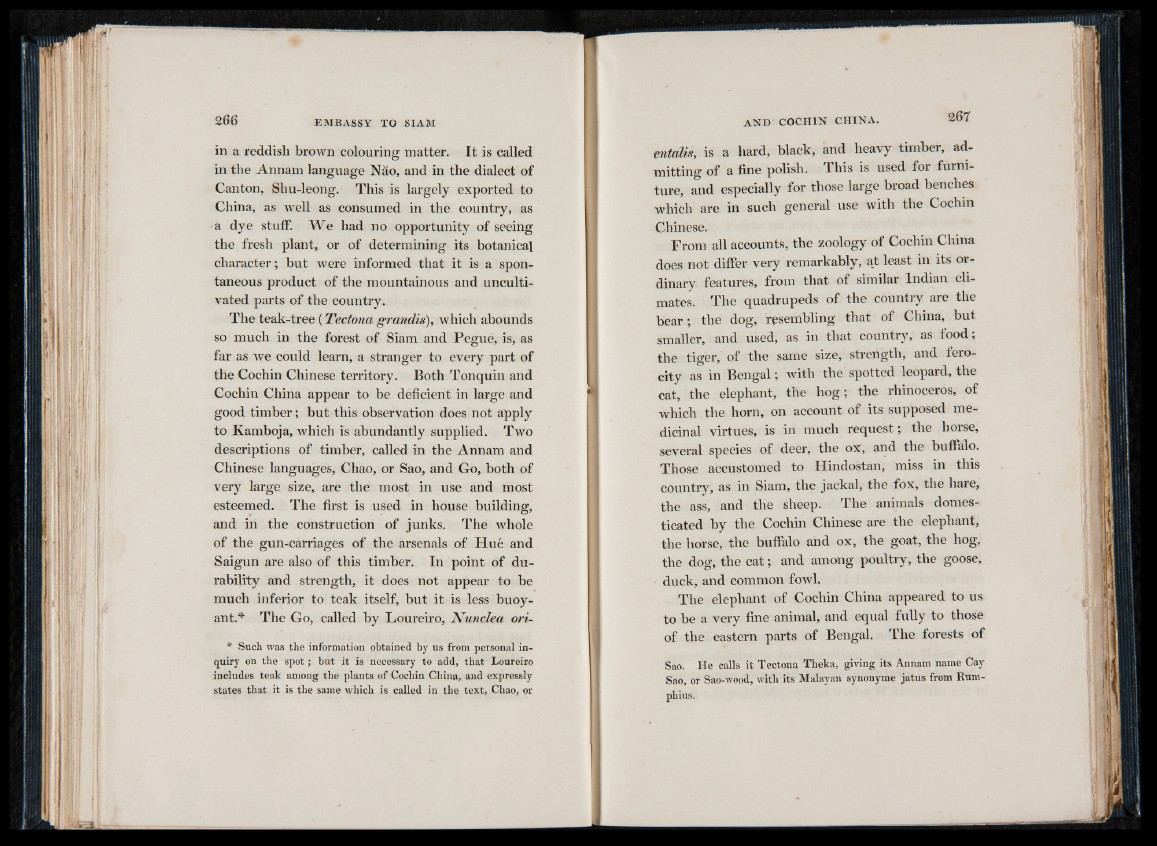
in a reddish brown colouring matter. I t is called
in the Annam language Nao, and in the dialect of
Canton, Shu-leong. This is largely exported to
China, as well as consumed in the country, as
a dye stuff. We had no opportunity of seeing
the fresh plant, or of determining its botanical
character ; but were informed that it is a spontaneous
product of the mountainous and uncultivated
parts of the country.
The teak-tree ( Tectona grandis), which abounds
so much in the forest of Siam and Pegue, is, as
far as we could learn, a stranger to every part of
the Cochin Chinese territory. Both Tonquin and
Cochin China appear to be deficient in large and
good timber ; but this observation does not apply
to Kamboja, which is abundantly supplied. Two
descriptions of timber, called in the Annam and
Chinese languages, Chao, or Sao, and Go, both of
very large size, are the most in use and most
esteemed. The first is used in house building,
and in the construction of junks. The whole
of the gun-carriages of the arsenals of Hué and
Saigun are also of this timber. In point of durability
and strength, it does not appear to be
much inferior to teak itself, but it is less buoyant.*
The Go, called by Loureiro, Nunclea ori-
* Such was the information obtained by us from personal inquiry
on the spot ; but it is necessary to add, that Loureiro
includes teak among the plants of Cochin China, and expressly
states that it is the same which is called in the text, Chao, or
entalis, is a hard, black, and heavy timber, admitting
of a fine polish. This is used for furniture,
and especially for those large broad benches
which are in such general use with the Cochin
Chinese.
From all accounts, the zoology of Cochin China
does not differ very remarkably, at least in its ordinary
features, from that of similar Indian climates.
The quadrupeds of the country are the
b e ar; the dog, resembling that of China, but
smaller, and used, as in that country, as food;
the tiger, of the same size, strength, and ferocity
as in Bengal; with the spotted leopard, the
cat, the elephant, the hog; the rhinoceros, of
which the horn, on account of its supposed medicinal
virtues, is in much request; the horse,
several species of deer, the ox, and the buffalo.
Those accustomed to Hindostan, miss in this
country, as in Siam, the jackal, the fox, the hare,
the ass, and the sheep. The animals domesticated
by the Cochin Chinese are the elephant,
the horse, the buffalo and ox, the goat, the hog,
the dog, the c a t; and among poultry, the goose,
duck, and common fowl.
The elephant of Cochin China appeared to us
to be a very fine animal, and equal fully to those
of the eastern parts of Bengal. The forests of
Sao. He calls it Tectona Theka, giving its Annam name Cay
Sao, or Sao-wood, with its Malayan synonyme jatus from Rum-
phius.